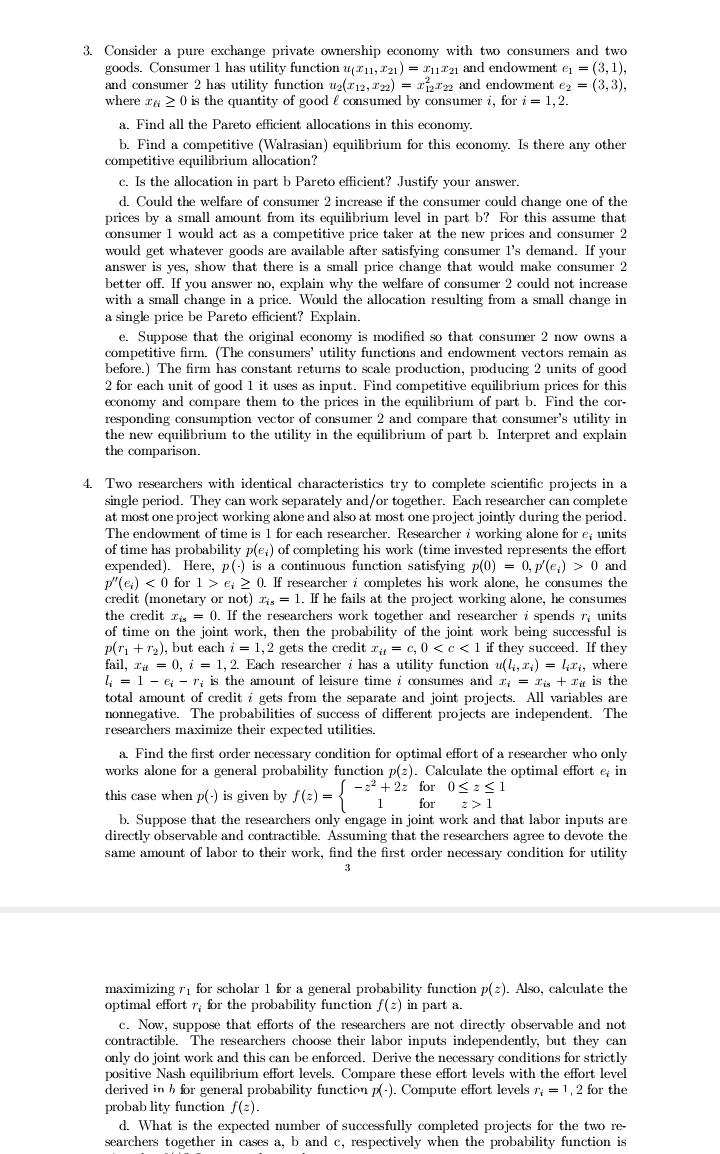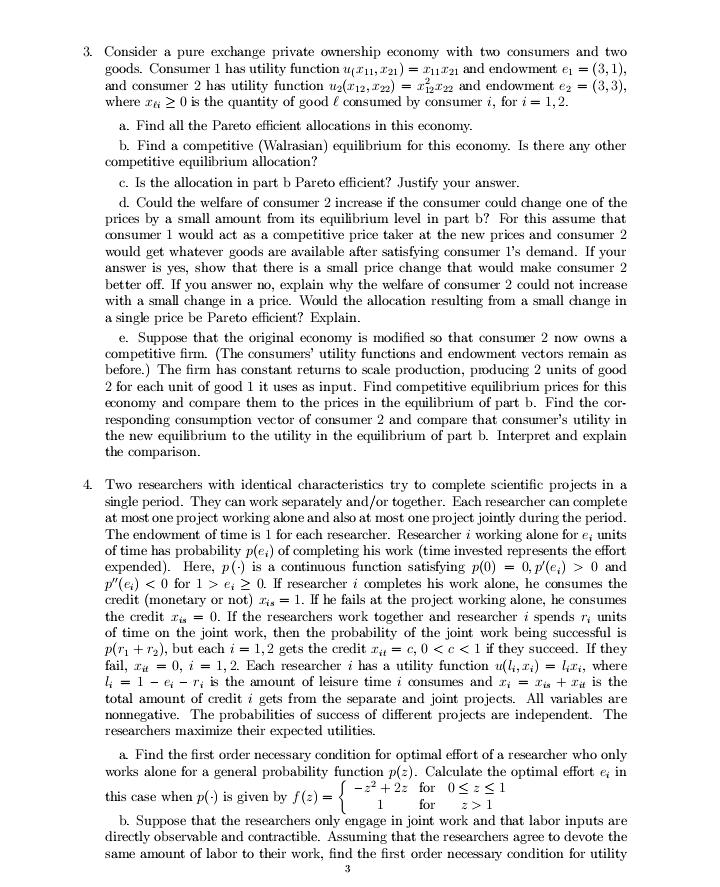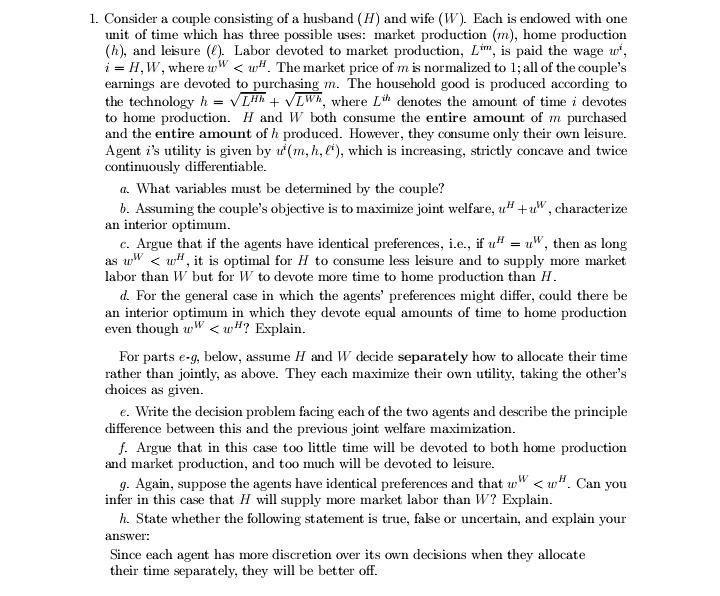




2 a. In light of the above, set up the decision problem facing firm i assuming each firm seeks to maximize its expected profit taking the other firm's output as given. (Do not solve the problem.) b. For the special case in which p(y, a) = -y + o, solve for the Cournot equilibrium as a function of the expected value of a, denoted a. c. Argue that if a > 3k, then firm I's revenue will be greater and it's costs less than firm 2's in Cournot equilibrium, and hence I's profits will be greater. d In light of part c, suppose that the government decides to subsidize firm 2 in the event of a loss in order to ensure that there remain at least two competitors in the industry. This works as follows. As before, the firms first engage in Cournot competition, choosing their output levels to maximize their expected profits. Market demand is then realized. If the market price is below firm 2's break-even price, denoted p(yz), the government would raise the price for firm 2 (only) so that it would be able to break even. Assuming firm 2 knows it will be subsidized in the event of a loss, explain how the government intervention would affect its decision problem. e. Discuss the effects of a and & on the likelihood of the need for government subsidiza- tion. f. Next, suppose that even when subsidies are not necessary (i.e., when firm 2 would be profitable otherwise), the government decides to provide a price subsidy to firm 2 since firm 1 has a cost advantage. In this case, firm I would receive the market price p(y, a), but firm 2 would receive p(y, o) + 8 per unit. Prove that this would always have the desired effect of increasing firm 2's market share relative to firm l's. 3. Apple's market research shows that there are two types of consumers for its iMac computer and bMac computer (baby iMac). The bMac is physically the same as the iMac but has some functions disabled. Both iMac and bMac cost 300 dollars to produce per unit. Both consumer types, h and I, get utility m if they have m dollars and no computer: up (0, m) = w(0, m) = m. High type consumers with m dollars (after paying for a computer) get utility us(i, m) = 1500 + m and us(b, m) = 800 + m, where i denotes having one iMac and b having one bMac. Low types get utility up(i, m) = 600 + m and w(b, m) = 500 + m. Apple knows that there are one million consumers of high type and 2 million consumers of low type. Once Apple announces a price, it must serve all consumers who demand its product at that price. The consumers start with enough money to buy a computer if it raises their utility. They demand at most one computer during the period considered. a. Suppose Apple sells iMacs at 1500/unit and bMacs at 500/unit. Find the maximum sales and profits Apple could get. b Suppose Apple offers only iMacs. Find profit maximizing price, sales and profit. c. Suppose Apple offers only bMacs. Find profit maximizing price, sales and profit. d. Suppose Apple offers iMacs at price pa and bMacs at price pr. Show that no prices are such that high types buy bMacs and low types buy iMacs. e. Find profit maximizing prices pa and p that can induce high types to buy the iMac and low types to buy the bMac. What is the corresponding profit? f. Do part e assuming instead that the number of low types is 1 million. In this case, find profit maximizing prices and compare the resulting profit to what Apple receives if it offers only the iMac at a profit maximizing price.3. Consider a pure exchange private ownership economy with two consumers and two goods. Consumer 1 has utility function u(711, 121) = InIn and endowment en = (3, 1), and consumer 2 has utility function u2(412, 122) = 192722 and endowment ez = (3, 3), where my 2 0 is the quantity of good & consumed by consumer i, for i = 1, 2. a. Find all the Pareto efficient allocations in this economy. b. Find a competitive (Walrasian) equilibrium for this economy. Is there any other competitive equilibrium allocation? c. Is the allocation in part b Pareto efficient? Justify your answer. d. Could the welfare of consumer 2 increase if the consumer could change one of the prices by a small amount from its equilibrium level in part b? For this assume that consumer I would act as a competitive price taker at the new prices and consumer 2 would get whatever goods are available after satisfying consumer I's demand. If your answer is yes, show that there is a small price change that would make consumer 2 better off. If you answer no, explain why the welfare of consumer 2 could not increase with a small change in a price. Would the allocation resulting from a small change in a single price be Pareto efficient? Explain. e. Suppose that the original economy is modified so that consumer 2 now owns a competitive firm. (The consumers' utility functions and endowment vectors remain as before.) The firm has constant returns to scale production, producing 2 units of good 2 for each unit of good 1 it uses as input. Find competitive equilibrium prices for this economy and compare them to the prices in the equilibrium of part b. Find the cor- responding consumption vector of consumer 2 and compare that consumer's utility in the new equilibrium to the utility in the equilibrium of part b. Interpret and explain the comparison. 4. Two researchers with identical characteristics try to complete scientific projects in a single period. They can work separately and/ or together. Each researcher can complete at most one project working alone and also at most one project jointly during the period. The endowment of time is 1 for each researcher. Researcher i working alone for e, units of time has probability p(e;) of completing his work (time invested represents the effort expended). Here, p(-) is a continuous function satisfying p(0) = 0, p'(e;) > 0 and "(@) e; 2 0. If researcher i completes his work alone, he consumes the credit (monetary or not) ris = 1. If he fails at the project working alone, he consumes the credit ris = 0. If the researchers work together and researcher i spends r, units of time on the joint work, then the probability of the joint work being successful is p(r, + 72), but each ? = 1, 2 gets the credit my = c, 0 1 b. Suppose that the researchers only engage in joint work and that labor inputs are directly observable and contractible. Assuming that the researchers agree to devote the same amount of labor to their work, find the first order necessary condition for utility maximizing ri for scholar 1 for a general probability function p(=). Also, calculate the optimal effort r, for the probability function f(z) in part a. c. Now, suppose that efforts of the researchers are not directly observable and not contractible. The researchers choose their labor inputs independently, but they can only do joint work and this can be enforced. Derive the necessary conditions for strictly positive Nash equilibrium effort levels. Compare these effort levels with the effort level derived in b for general probability function p( ). Compute effort levels ry = 1, 2 for the probablety function f(z). d. What is the expected number of successfully completed projects for the two re- searchers together in cases a, b and c, respectively when the probability function is3. Consider a pure exchange private ownership economy with two consumers and two goods. Consumer 1 has utility function u($1, 121 ) = Turn and endowment en = (3, 1), and consumer 2 has utility function u2(712, 122) = 12722 and endowment e2 = (3,3), where za 2 0 is the quantity of good / consumed by consumer i, for i = 1, 2. a. Find all the Pareto efficient allocations in this economy. b. Find a competitive (Walrasian) equilibrium for this economy. Is there any other competitive equilibrium allocation? c. Is the allocation in part b Pareto efficient? Justify your answer. d. Could the welfare of consumer 2 increase if the consumer could change one of the prices by a small amount from its equilibrium level in part b? For this assume that consumer I would act as a competitive price taker at the new prices and consumer 2 would get whatever goods are available after satisfying consumer I's demand. If your answer is yes, show that there is a small price change that would make consumer 2 better off. If you answer no, explain why the welfare of consumer 2 could not increase with a small change in a price. Would the allocation resulting from a small change in a single price be Pareto efficient? Explain. e. Suppose that the original economy is modified so that consumer 2 now owns a competitive firm. (The consumers' utility functions and endowment vectors remain as before.) The firm has constant returns to scale production, producing 2 units of good 2 for each unit of good 1 it uses as input. Find competitive equilibrium prices for this economy and compare them to the prices in the equilibrium of part b. Find the cor- responding consumption vector of consumer 2 and compare that consumer's utility in the new equilibrium to the utility in the equilibrium of part b. Interpret and explain the comparison. 4. Two researchers with identical characteristics try to complete scientific projects in a single period. They can work separately and/ or together. Each researcher can complete at most one project working alone and also at most one project jointly during the period. The endowment of time is 1 for each researcher. Researcher i working alone for e, units of time has probability p(e;) of completing his work (time invested represents the effort expended). Here, p(-) is a continuous function satisfying p(0) = 0, p'(e;) > 0 and p/"(e ) e; 2 0. If researcher i completes his work alone, he consumes the credit (monetary or not) mis = 1. If he fails at the project working alone, he consumes the credit ris = 0. If the researchers work together and researcher i spends r, units of time on the joint work, then the probability of the joint work being successful is p(r, + 72), but each i = 1,2 gets the credit my = c, 0 0 no matter what. In other words, no matter what the worker decides, c is subtracted from the manager's payoff specified above. Before deciding whether to accept the job, the worker knows if a gift has been given. The manager and worker are both rational expected payoff maximizers with common knowledge of the entire interaction described above. (In particular, the manager knows the value of p.) a. The above interaction can be represented as a sequential ( extensive form) game. Draw a complete game tree representing this game. The tree should include all the possible choices of the manager and worker given their respective information. Define all the notation you introduce in labeling the tree. b. How many pure strategies does the manager have? Give an example of one. c. How many pure strategies does the worker have? Give an example of one. d. Suppose that, for some values of the parameters p and c, there is a pure strategy sequential equilibrium (SE) in which the manager never gives a gift under any circum- stances. To formulate the SE, it is still necessary to specify the worker's beliefs in case the manager did give a gift. Show that sequential equilibrium places no restriction on those beliefs. e. Find all parameter values of the game in part a such that there is a pure strategy SE in which the manager never gives a gift under any circumstances. Describe the SE completely when it exists and show that it is SE. f. Find all parameter values of the game in part a such that there is a pure strategy SE in which the manager gives a gift if and only if working for the firm is pleasant. Describe the SE completely when it exists and show that it is SE. Explain why the equilibrium strategies of manager and worker are equilibrium strategies. g. Find some set of parameter values and a corresponding SE such that the manager gives a gift under all circumstances. Show that the SE is SE. h. Whenever the manager chooses to give a gift, it might seem that the same pur- pose could have been achieved by making the conditions in the original job offer more attractive. Why might it make economic sense to model the interaction so that there is a difference between the manager giving the gift and making the original offer more attractive
















